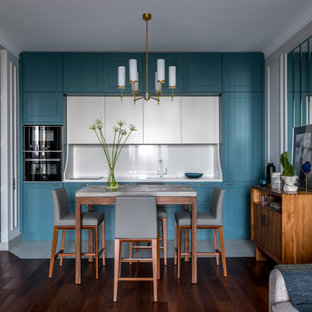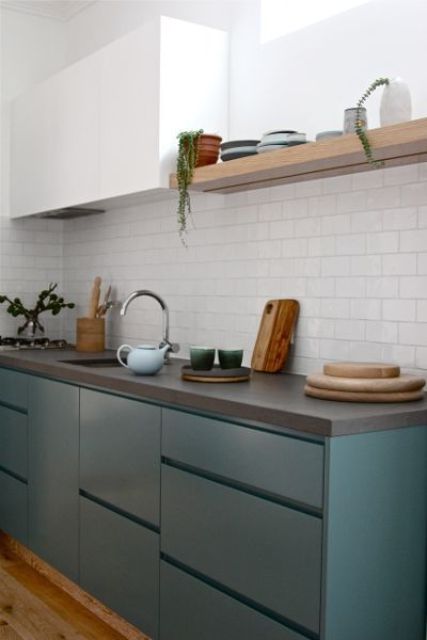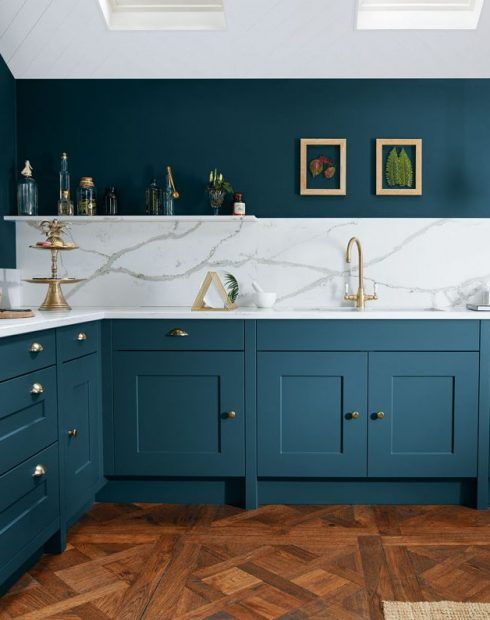Turquoise kitchen countertops are a bold and visually striking choice for any kitchen design. This vibrant color brings a sense of energy, warmth, and coastal beauty to a space, making it ideal for homeowners who want to make a design statement. Whether you opt for solid turquoise countertops or a pattern with subtle turquoise accents, the color evokes feelings of tranquility and creativity. When incorporating turquoise countertops into your kitchen, it’s important to consider the overall aesthetic and how the countertops will interact with other elements like cabinetry, flooring, and appliances. The key to successfully integrating this eye-catching color is balancing it with complementary shades, textures, and materials to ensure that the room feels cohesive and harmonious.
One of the primary benefits of turquoise countertops is their ability to brighten up a kitchen. This color instantly draws attention, creating a focal point in the room that naturally enhances the overall aesthetic. In kitchens with neutral or white cabinets, turquoise countertops provide a pop of color that can make the space feel more lively and inviting. The beauty of turquoise is that it works well in both modern and traditional kitchen designs. In modern spaces, it offers a sleek and vibrant appearance, while in traditional kitchens, it can evoke a charming, vintage feel.

Another advantage of turquoise kitchen countertops is their versatility. While the color itself may seem bold, turquoise can actually complement a wide range of color palettes. For example, it pairs beautifully with whites, creams, and beiges for a beachy, coastal vibe. It also works well with deeper shades like navy blue, charcoal, or even black for a more dramatic, modern look. The key is to choose complementary colors that balance the vibrancy of the turquoise without overwhelming the space. This versatility makes turquoise countertops a viable option for homeowners who want to experiment with color without committing to an entire kitchen overhaul.
In terms of materials, turquoise countertops are available in various options, including quartz, granite, and laminate. Quartz is a popular choice due to its durability and low maintenance, while granite offers natural beauty with unique variations in pattern and texture. Laminate countertops, on the other hand, provide an affordable option for homeowners looking to achieve the turquoise look without breaking the bank. Each material has its own pros and cons, so it’s important to consider your budget, lifestyle, and design preferences when choosing the right turquoise countertop material for your kitchen.

When it comes to design, turquoise countertops can serve as either a subtle accent or the star of the show, depending on the amount of color and pattern you choose. Solid turquoise countertops make a bold statement, ideal for modern or minimalist kitchens where simplicity and clean lines are key. On the other hand, turquoise countertops with veining or patterns can add depth and texture to the space, creating a more dynamic and layered look. Homeowners should also consider how much of the turquoise countertop they want to showcase—whether as a central island feature or throughout the entire kitchen.
The finish of turquoise countertops is another important factor to consider. A high-gloss finish will amplify the vibrant color and make the countertops the focal point of the kitchen, while a matte finish offers a more subdued and sophisticated look. Both finishes have their advantages, and the choice ultimately depends on the overall aesthetic you want to achieve. High-gloss finishes work well in modern kitchens with sleek, reflective surfaces, while matte finishes lend themselves to a more rustic or industrial design.

Turquoise countertops can also influence the lighting in your kitchen. Since the color is bright and reflective, it naturally enhances the light in the room, making the kitchen feel larger and more open. This is particularly beneficial in smaller kitchens or kitchens with limited natural light, as the turquoise countertops can create the illusion of a more spacious and airy environment. Pairing turquoise countertops with good lighting, such as under-cabinet lights or pendant lights, can further enhance the overall brightness and appeal of the space.
Maintenance is an important consideration when selecting turquoise kitchen countertops. As with any colored countertop, it’s crucial to choose a material that is easy to clean and resistant to stains. Quartz is particularly known for its non-porous surface, which makes it resistant to staining and easy to maintain. Granite, while durable, may require sealing to prevent stains from penetrating the surface. Laminate countertops are relatively low-maintenance, but they can be susceptible to scratches and heat damage. Regardless of the material, regular cleaning and care are essential to keeping your turquoise countertops looking their best.
Turquoise countertops can also impact the mood of your kitchen. The color turquoise is often associated with calmness, relaxation, and creativity, making it an ideal choice for homeowners who want to create a peaceful yet inspiring environment. In kitchens where the countertops are a focal point, the color can set the tone for the entire space, influencing the mood and energy of the room. For example, in a busy family kitchen, turquoise countertops can provide a sense of calm and balance, while in a creative cooking space, they can inspire innovation and imagination.

While turquoise countertops can make a bold statement, they don’t have to dominate the kitchen. By incorporating subtle turquoise accents elsewhere in the room—such as in the backsplash, bar stools, or decorative accessories—you can create a cohesive look that ties everything together. These accents help to reinforce the turquoise theme without overwhelming the space, ensuring that the kitchen feels balanced and thoughtfully designed. Small touches of turquoise can also allow homeowners to enjoy the color without fully committing to bright countertops.
Choosing turquoise countertops offers an opportunity to get creative with texture. For example, pairing the smooth, glossy surface of the countertops with rustic wooden cabinetry can create a beautiful contrast, blending modern and natural elements. Alternatively, combining turquoise countertops with metallic accents—such as stainless steel appliances or brass fixtures—can enhance the sophistication and modernity of the kitchen. Mixing different textures and materials helps to create a layered, visually interesting design.
Another important consideration is how turquoise countertops fit into the overall theme of your home. In open-plan layouts, where the kitchen flows into the living or dining areas, it’s important to ensure that the countertops complement the surrounding spaces. If your home has a coastal or beachy vibe, turquoise countertops are a perfect fit. For more contemporary or industrial designs, pairing turquoise with neutral or metallic tones can create a chic, modern look.

If you’re concerned about the long-term appeal of turquoise countertops, consider their timelessness in certain design styles. While some may view turquoise as trendy, it has deep roots in vintage and retro design, meaning it can also offer a timeless appeal when incorporated thoughtfully. In mid-century modern kitchens, for example, turquoise countertops evoke a sense of nostalgia and charm, while in Mediterranean-inspired kitchens, they bring warmth and vibrancy that never goes out of style.
It’s essential to ensure that turquoise countertops are well-coordinated with your kitchen appliances. Stainless steel appliances tend to pair well with the vibrant color, offering a sleek contrast that balances out the boldness of the turquoise. Alternatively, for a more cohesive look, you could consider appliances in complementary shades, such as white or light gray, which allow the turquoise to remain the focal point. Choosing the right appliances can enhance the overall aesthetic of the kitchen and help you achieve the desired design style.
Finally, turquoise kitchen countertops offer a unique opportunity to express your personal style. Whether you’re drawn to the energy and brightness of turquoise or its calming and serene qualities, this color provides endless possibilities for customization. With careful planning and attention to detail, turquoise countertops can transform your kitchen into a space that is both visually stunning and functional, while reflecting your personal design preferences.

Common Mistakes to Avoid
One of the most common mistakes when installing turquoise countertops is neglecting to consider how the color will interact with the rest of the kitchen. Failing to balance the boldness of turquoise with neutral or complementary colors can lead to a kitchen that feels overwhelming and visually chaotic.
Another mistake is choosing the wrong material for your lifestyle. While turquoise quartz may be low maintenance, turquoise granite may require sealing and more frequent care, which may not suit everyone’s needs. Homeowners may also forget to consider how their countertops will pair with appliances and lighting, which can affect the overall harmony of the space. Additionally, choosing a countertop with too busy a pattern can detract from the beauty of the color itself, making the design feel cluttered.

How do I coordinate turquoise countertops with the rest of my kitchen design?
Coordinating turquoise countertops with the rest of your kitchen requires a careful balance of colors, materials, and textures. Start by pairing the countertops with neutral shades like white, gray, or beige for cabinetry and walls. This helps to soften the vibrancy of the turquoise. For a bolder look, you can incorporate complementary colors, such as deep blues or greens. Accessories like bar stools, backsplashes, or even small appliances in coordinating hues can tie the whole design together.
What materials are best for turquoise kitchen countertops?
Turquoise countertops are available in various materials, each with its own benefits. Quartz is a popular choice because it’s durable, non-porous, and low-maintenance. Granite offers a natural look with unique veining patterns but requires periodic sealing to protect against stains. Laminate countertops provide an affordable option and come in a wide range of turquoise shades, though they may be more susceptible to damage from heat or sharp objects. The best material depends on your budget and lifestyle.
Will turquoise countertops go out of style?
While turquoise may seem like a bold or trendy choice, it has timeless appeal in certain design styles, such as mid-century modern or coastal themes. If integrated thoughtfully, turquoise countertops can remain stylish for years to come. Additionally, the color turquoise has long been associated with calmness and creativity, making it a versatile option that can transcend fleeting trends.

How do I care for turquoise kitchen countertops?
The care required for turquoise countertops largely depends on the material. For quartz, regular cleaning with mild soap and water is sufficient to maintain its appearance, as it is resistant to stains and scratches. Granite countertops should be sealed periodically to protect against moisture and staining. Laminate countertops require gentle cleaning and care to avoid scratches or burns. Regardless of the material, avoid abrasive cleaners and always clean up spills immediately to prevent long-term damage.
Can I install turquoise countertops in a small kitchen?
Yes, turquoise countertops can work beautifully in small kitchens, especially when paired with lighter cabinetry and good lighting. The brightness of the turquoise can make a small space feel more open and lively. To avoid overwhelming the space, consider using turquoise as an accent, such as on an island, rather than throughout the entire kitchen. This will add a pop of color without dominating the room.
What are some complementary colors for turquoise countertops?
Complementary colors for turquoise countertops include neutral tones like white, cream, and beige, which help balance out the boldness of the turquoise. Deep navy, charcoal gray, or even soft pinks can also work well, adding depth and contrast to the design. For a more cohesive look, consider using gold or brass hardware, which complements the warmth of the turquoise. The key is to select colors that enhance the vibrancy of the countertops without competing with them.

Yes or No to Carrara Marble Countertops in the Kitchen?

RMS Stonex Blue Onyx Marbles, 18 mm, Rs 1150 /square feet

Kitchen Room Scene Fairy White Quartz Countertop White quartz countertop, Quartz countertops

Choose best Color for small kitchen remodel Home to Z Teal kitchen, Teal kitchen cabinets

Beautiful Coastal Kitchen Decor Ideas That Are Worth Seeing Coastal kitchen decor

Related Posts:
- Kitchen Countertop Hutch
- Ceramic Tile Kitchen Countertops Pictures
- Bamboo Kitchen Countertops Cost
- Quartz Kitchen Countertop Materials
- White Kitchen Cabinets With Gray Quartz Countertops
- Wood Kitchen Countertops Care
- Kitchen Countertops Dallas
- Cottage Kitchen Countertop Ideas
- Quartz Kitchen Countertops Reviews
- Kitchen Countertops Greenville Sc